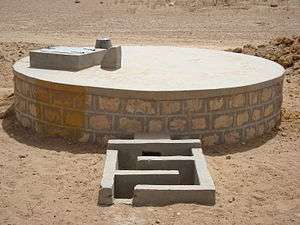Water tank

A water tank is a container for storing liquid. The need for a water tank is as old as civilization, to provide storage of water for use in many applications, drinking water, irrigation agriculture, fire suppression, agricultural farming, both for plants and livestock, chemical manufacturing, food preparation as well as many other uses. Water tank parameters include the general design of the tank, and choice of construction materials, linings. Various materials are used for making a water tank: plastics (polyethylene, polypropylene), fiberglass, concrete, stone, steel (welded or bolted, carbon, or stainless). Earthen pots also function as water storages. Water tanks are an efficient way to help developing countries to store clean water.
History

Throughout history, wood, ceramic and stone have been used as water tanks.[1] These containers were all naturally occurring and some man made and a few of these tanks are still in service. The Indus Valley Civilization (3000–1500 BC) made use of granaries and water tanks. Medieval castles needed water tanks for the defenders to withstand a siege. A wooden water tank found at the Año Nuevo State Reserve (California) was restored to functionality after being found completely overgrown with ivy. It had been built in 1884.
Types
Chemical contact tank of FDA and NSF polyethylene construction, allows for retention time for chemical treatment chemicals to "contact" (chemically treat) with product water.
Ground water tank, made of lined carbon steel, may receive water from a water well or from surface water, allowing a large volume of water to be placed in inventory and used during peak demand cycles.
Elevated water tank, also known as a water tower, will create a pressure at the ground-level outlet of 1 kPa per 10.2 cm or 1 psi per 2.31 feet of elevation. Thus a tank elevated to 20 metres creates about 200 kPa and a tank elevated to 70 feet creates about 30 psi of discharge pressure, sufficient for most domestic and industrial requirements.
Vertical cylindrical dome top tanks may hold from 200 litres or fifty gallons to several million gallons. Horizontal cylindrical tanks are typically used for transport because their low-profile creates a low center of gravity helping to maintain equilibrium for the transport vehicle, trailer or truck.
A Hydro-pneumatic tank is typically a horizontal pressurized storage tank. Pressurizing this reservoir of water creates a surge free delivery of stored water into the distribution system.
Design
By design a water tank or container should do no harm to the water. Water is susceptible to a number of ambient negative influences, including bacteria, viruses, algae, changes in pH, and accumulation of minerals, accumulated gas. The contamination can come from a variety of origins including piping, tank construction materials, animal and bird feces, mineral and gas intrusion. A correctly designed water tank works to address and mitigate these negative effects.
A safety based news article linked copper poisoning as originating from a plastic tank. The article indicated that rainwater was collected and stored in a plastic tank and that the tank did nothing to mitigate the low pH. The water was then brought into homes with copper piping, the copper was released by the high acid rainwater and caused poisoning in humans. It is important to note that since the plastic tank is an inert container, it has no effect on the incoming water. Good practice would be to analyze any water source periodically and treat accordingly, in this case the collected acid rain should be analyzed, and pH adjusted before being brought into a domestic water supply system.
The release of copper due to acidic water is monitored may be accomplished with a variety of technology, beginning with pH strips and going to more sophisticated pH monitors, indicate pH which when acidic or caustic, some with output communication capabilities. There is no "linkage" between the plastic tank and copper poisoning, a solution to the problem is easy, monitor 'stored rainwater' with 'swimming pool strips' cheap and available at, swimming pool supply outlets. If the water is too acidic, contact state/county/local health officials to obtain advice and precise solutions and pH limits and guidelines as to what should be used to treat rainwater to be used as domestic drinking water.
Articles and specifications for water tank applications and design considerations, the AWWA (American Water Works Association) provides details as required by many states to complete a certification process to insure the quality of water being consumed.
The American Water Works Association is a reservoir of water tank knowledge; the association provides specifications for a variety of water storage tank applications as well as design. The AWWA's site provides scientific resources with which the reader will be able to develop an informed perspective on which to make decisions regarding their water tank requirements.
See also
- Chemical tank
- Cistern
- Domestic water system
- Hand pump
- Household drinking water storage
- Intermediate bulk container
- Portable water tank
- Potable water diver
- Rainwater tank
References
- ↑ "Water Storage and Wastewater Treatment Solutions". Greatbasinindustrial. Retrieved 2016-08-16.
External links
| Wikimedia Commons has media related to Water tanks. |
- Drinking Water Contaminants - United States Environmental Protection Agency
- Año Nuevo Water Tank - California Department of Parks and Recreation
- - American Water Works Association
